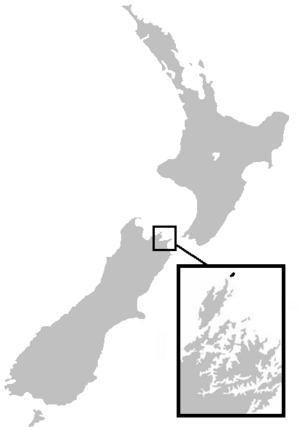Hamilton's frog facts for kids
Quick facts for kids Hamilton's frog |
|
|---|---|
 |
|
| Conservation status | |
 Nationally Critical (NZ TCS) |
|
| Scientific classification | |
| Genus: |
Leiopelma
|
| Species: |
hamiltoni
|
 |
|
| Range of Leiopelma hamiltoni. | |
The Hamilton's frog (Leiopelma hamiltoni) is a special type of frog that lives only in New Zealand. It's one of just four types of ancient frogs left in a group called Leiopelmatidae. These frogs are unique because the dad frog stays with the eggs to keep them safe. He even lets the tiny froglets (baby frogs) climb onto his back to stay moist! This frog is named after Harold Hamilton, who first found a sample of it. You can find the original sample at the Museum of New Zealand Te Papa Tongarewa.
Contents
What Does Hamilton's Frog Look Like?
Even though it's the biggest native frog in New Zealand, the Hamilton's frog is quite small compared to frogs from other parts of the world. Male frogs can grow up to 43 millimeters (about 1.7 inches) long, and females are a bit bigger, reaching about 52 millimeters (about 2 inches).
Most of these frogs are light brown, which helps them blend in with their surroundings. However, some green ones have also been seen! They have a dark stripe that goes along each side of their head and through their eye. Unlike many other frogs, Hamilton's frogs do not have webbing between their toes or fingers.
Where Do Hamilton's Frogs Live?
Today, Hamilton's frogs only live in a very small, rocky area on Stephens Island. This island is located in the Cook Strait and is special because it doesn't have any mammals that could harm the frogs.
Scientists have found old fossils that show Hamilton's frogs used to live in many more places. They once lived across the lower part of the North Island and the upper part of the South Island of New Zealand. These frogs like to live in places that are rocky, moist, and have grass.
Daily Life and Diet
Hamilton's frogs are ground-dwelling animals, meaning they live on the ground. They are also nocturnal, which means they are active at night. During the day, they hide in damp cracks and crevices to stay safe and cool.
It can be really hard to find these frogs! They are very rare, and their brown color helps them blend in perfectly with their surroundings. Plus, they don't make loud croaking sounds like many other frogs, which makes them even harder to spot.
Life Cycle of Hamilton's Frog
Hamilton's frogs have a unique way of growing up. They don't go through a tadpole stage like most frogs. Instead, their entire development happens inside a jelly-like egg capsule. When they hatch, they come out as tiny froglets, which are basically miniature versions of adult frogs. It takes them about three years to become fully grown and ready to have their own babies.
Hamilton's frogs are insectivores, meaning they eat insects. Their diet includes small creatures like fruit flies, tiny crickets, moths, and springtails. Young frogs that are 20 millimeters (about 0.8 inches) or smaller don't have teeth. This means they need to eat soft-bodied insects, such as mites and fruit flies.
Protecting Hamilton's Frog
The Hamilton's frog faces a few big dangers. Its main predators are the native tuatara (Sphenodon punctatus) and the black rat (Rattus rattus), which was brought to New Zealand by humans. Both of these animals have caused the number of Hamilton's frogs to drop dramatically, with fewer than 300 left. These frogs are also at risk from a disease called chytrid fungus (Batrachochytrium dendrobatidis), which can be deadly for amphibians.
In August 2018, the Department of Conservation (DOC) in New Zealand officially listed the Hamilton's frog as "Nationally Critical." This means they are in extreme danger of disappearing from New Zealand.
Conservation Efforts
New Zealand has been working to protect the Hamilton's frog since 1921. Many efforts are in place to help them survive:
- A special fence has been built to keep tuataras away from the frog's habitat.
- Scientists regularly check on the frog population to see how they are doing.
- There are also plans to move some of the frogs to another island to create a new, safe home for them.
See also
 In Spanish: Leiopelma hamiltoni para niños
In Spanish: Leiopelma hamiltoni para niños


